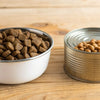Understanding What Is in Dry Dog Food: A Comprehensive Guide
- Houndsy
Table of Contents
- Introduction
- The Basics of Dry Dog Food
- Nutritional Needs of Dogs
- The Impact of Ingredients on Health
- Choosing the Right Dry Dog Food
- How the Houndsy Kibble Dispenser Enhances the Feeding Experience
- Conclusion
Introduction
As devoted pet owners, we often find ourselves standing in the pet food aisle, contemplating which kibble to bring home for our furry companions. With so many options available, it’s natural to wonder: What exactly is in dry dog food? According to the American Pet Products Association, the pet food industry was projected to reach over $23 billion in the U.S. alone by 2022, signifying the importance of understanding what goes into our pets’ diets.
The nutritional quality of dog food can significantly impact our dogs' health, energy levels, and overall well-being. The ingredients we feed our pets matter more than we often realize. In this blog post, we will explore the essential components that make up dry dog food, the nutrients your dog needs, how to read labels effectively, and how our flagship product, the Houndsy Kibble Dispenser, can elevate your dog's feeding experience.
By the end of this article, you'll have a deeper understanding of the components of dry dog food, enabling you to make informed choices for your furry friends. So, let’s dive into the fascinating world of kibble and discover what it truly contains.
The Basics of Dry Dog Food
Before we delve into the specifics, let’s start with a clear definition. Dry dog food, commonly referred to as kibble, is a commercially produced pet food that is primarily made of a mixture of various ingredients, including proteins, carbohydrates, fats, vitamins, and minerals. Kibble is made using a process called extrusion, which involves cooking the ingredients at high temperatures and then shaping them into the familiar bite-sized pieces.
The Ingredients of Dry Dog Food
Understanding what is in dry dog food starts with examining the core ingredients. Here are the primary components:
-
Proteins:
- Animal Proteins: These are the main sources of protein in dog food and can include chicken, beef, lamb, and fish. Proteins are crucial for growth, repair, and overall health.
- Plant Proteins: Ingredients like soy and peas are also commonly used. However, it’s important to note that animal-based proteins are generally more digestible for dogs.
-
Carbohydrates:
- Carbohydrates serve as a source of energy and can include grains like rice, corn, and barley. While these provide energy, the quality and quantity of carbohydrates in dog food can vary significantly.
- Fiber Sources: Ingredients like beet pulp and chicory root act as sources of dietary fiber, which supports digestive health.
-
Fats:
- Fats are vital for energy and help maintain healthy skin and coat. High-quality fats, such as fish oil, provide essential fatty acids like omega-3 and omega-6, which support overall health.
-
Vitamins and Minerals:
- Essential vitamins (A, D, E, K, B-complex) and minerals (calcium, phosphorus, magnesium, etc.) are crucial for various bodily functions, including immune support and bone health.
-
Preservatives and Additives:
- To extend shelf life and maintain freshness, many dog foods contain preservatives, both natural (like mixed tocopherols) and artificial (like BHA and BHT).
- Probiotics are often added to support gut health.
-
Fillers:
- While some ingredients like corn and wheat are often criticized as fillers, they can provide energy and fiber. However, high amounts of these ingredients may not align with a dog’s carnivorous needs.
What to Look for in a Dog Food Label
When choosing dry dog food, understanding how to read the label is crucial. Here are key elements to consider:
- Ingredient List: Ingredients are listed in descending order by weight. The first few ingredients should ideally be high-quality animal proteins followed by wholesome carbohydrates.
- Guaranteed Analysis: This section provides information on the percentages of key nutrients, including protein, fat, fiber, and moisture content.
- Nutritional Adequacy Statement: This statement confirms that the food meets the standards set by the Association of American Feed Control Officials (AAFCO) for a complete and balanced diet.
- Best By or Expiration Date: Always check for freshness to ensure your dog is receiving high-quality food.
Nutritional Needs of Dogs
Just like humans, dogs have specific nutritional needs that vary based on their age, size, and activity level. Here’s a breakdown of the essential nutrients:
1. Proteins
Proteins are the building blocks of life and are essential for muscle growth and repair. Dogs require a higher proportion of protein than many people realize, especially active breeds. Quality sources of protein include:
- Meat: Chicken, beef, turkey, and lamb are excellent sources.
- Fish: Salmon and other fish provide not only protein but also beneficial omega fatty acids.
2. Carbohydrates
While dogs can digest carbohydrates, they do not require them in large quantities. Carbohydrates should primarily come from high-quality sources such as:
- Whole Grains: Brown rice and oats are better options compared to processed grains.
- Vegetables: Sweet potatoes and peas can be great additions for both energy and fiber.
3. Fats
Fats are essential for energy and play a crucial role in skin and coat health. Look for:
- Animal Fats: Chicken fat and fish oil provide necessary fatty acids.
- Plant Oils: Flaxseed oil and canola oil are good sources of omega fatty acids.
4. Vitamins and Minerals
A balanced diet must include vitamins and minerals to support various bodily functions. Ensure the food contains:
- Calcium and Phosphorus: Essential for bone health.
- Vitamins A, D, E, and B-complex: Important for overall health and immune function.
The Impact of Ingredients on Health
The ingredients in your dog’s food can directly affect their health. Higher-quality ingredients can lead to better digestion, healthier skin, and a shinier coat. Here are some aspects to consider:
1. Allergies and Sensitivities
Some dogs may develop allergies to specific ingredients, commonly proteins like chicken or grains like wheat. If you notice signs of allergies, such as itching, gastrointestinal upset, or ear infections, consult your veterinarian to determine the best dietary adjustments.
2. Weight Management
The caloric content of kibble varies widely. Overfeeding or choosing high-calorie foods can lead to obesity, which poses numerous health risks. Always refer to feeding guidelines and monitor your dog’s weight regularly.
3. Digestive Health
High fiber content aids in digestive health, promoting regular bowel movements and preventing issues such as constipation. Foods with prebiotics and probiotics can also support gut health.
Choosing the Right Dry Dog Food
With so many brands and formulations available, choosing the right dry dog food can feel overwhelming. Here are a few tips to streamline your selection process:
1. Research Brands
Look for brands that prioritize high-quality ingredients and transparency in their sourcing. Check for AAFCO approval and consult customer reviews.
2. Consider Your Dog’s Specific Needs
Different breeds and life stages require different nutritional profiles. Puppies, adult dogs, and senior dogs all have unique dietary needs.
3. Consult Your Veterinarian
Your veterinarian can provide personalized recommendations based on your dog’s health, age, and lifestyle. This is especially important if your dog has any specific health concerns.
How the Houndsy Kibble Dispenser Enhances the Feeding Experience
At Houndsy, we understand the importance of a well-balanced diet for our furry friends, which is why we’ve designed our flagship product, the Houndsy Kibble Dispenser. This innovative product simplifies the feeding experience while ensuring your dog gets the right portions every time.
Key Features of the Houndsy Kibble Dispenser
- Convenient Crank Design: The dispenser features an ergonomic crank that allows for easy dispensing at standing height, eliminating the need to bend over while feeding.
- Perfect Portion Control: Our dispenser provides consistent portion sizes, making it easier to manage your dog’s diet and prevent overfeeding.
- Stylish Mid-Century Modern Design: The Houndsy Kibble Dispenser complements your home decor, making it as aesthetically pleasing as it is functional.
- Large Storage Capacity: With a capacity of 25–30 lbs, it keeps your dog’s food fresh and readily available.
- Safety Features: The auto-locking mechanism prevents accidental dispensing by curious pets or toddlers.
Feeding your dog should be a joyful experience, and with the Houndsy Kibble Dispenser, we make it simpler, cleaner, and more enjoyable. Explore our Houndsy Kibble Dispenser product page and elevate your dog-feeding ritual today.
Conclusion
Understanding what is in dry dog food is crucial for making informed decisions about our pets' diets. By prioritizing high-quality ingredients and being mindful of nutritional needs, we can significantly impact our dogs’ health and happiness.
As we’ve explored, dry dog food consists of essential proteins, carbohydrates, fats, vitamins, and minerals. It’s important to read labels carefully and choose products that align with your dog’s specific needs. Additionally, incorporating the Houndsy Kibble Dispenser can enhance your feeding routine by ensuring convenience and portion control.
Remember, a well-fed dog is a happy dog! So, take some time to reflect on your pet’s feeding routine and consider whether it might be time for a change. For more information and to order the Houndsy Kibble Dispenser, visit our website.
FAQ
What are the main ingredients in dry dog food?
The main ingredients typically include animal proteins, carbohydrates (such as grains and vegetables), fats, vitamins, and minerals.
How can I tell if dry dog food is of good quality?
Look for high-quality animal proteins as the first ingredient, a balanced nutrient profile, and AAFCO approval on the label.
Are grains harmful to dogs?
Not necessarily. While some dogs may have sensitivities to grains, many can digest them without issues. It’s essential to choose high-quality grains and monitor your dog for any signs of allergies.
How should I store dry dog food?
Keep dry dog food in a cool, dry place in an airtight container to maintain freshness and prevent pests.
Can I mix wet food with dry kibble?
Yes, many pet owners choose to mix wet and dry food to provide variety and enhance palatability. Just be mindful of the total caloric intake.
What is the Houndsy Kibble Dispenser?
The Houndsy Kibble Dispenser is an innovative feeding solution designed to provide convenient, perfect portion control while ensuring that your dog’s feeding experience is clean and stylish.












